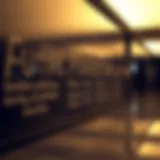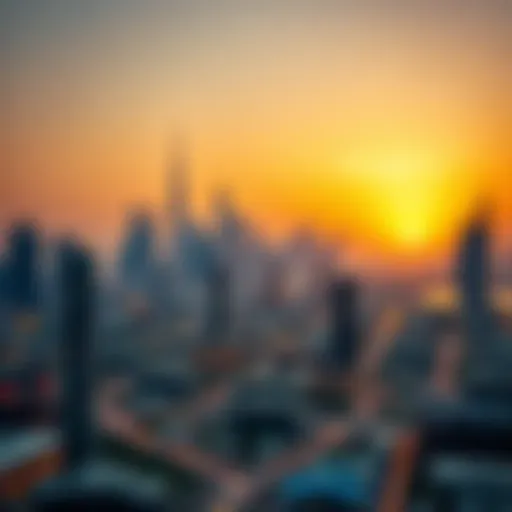Discovering Opportunities in the Dubai Metropolitan Area
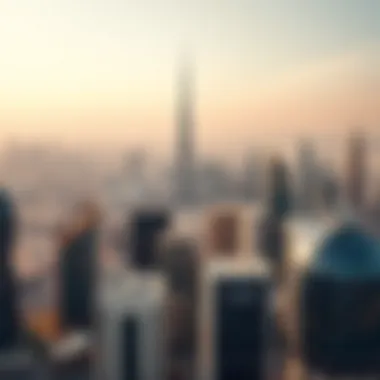

Intro
The Dubai Metropolitan Area stands as a striking example of the intertwining of tradition and modernity. In a region renowned for its rapid transformation and remarkable architectural feats, settling in or investing in this area is not just about finding a place to call home or a profitable opportunity; it's about immersing in a diverse cultural landscape thriving on innovation and growth.
With a unique blend of skyscrapers, lush parks, and a mosaic of cultures, Dubai doesn’t just catch the eye but also the imagination. Here, the local market pulses with potential, driven by a youthful population and an economy set on diversification. As we explore the housing dynamics and investment prospects, there is much to uncover about why the Dubai Metropolitan Area is a magnet for investors, buyers, and real estate professionals alike.
Intro to the Dubai Metropolitan Area
The Dubai Metropolitan Area stands as a beacon of modernity and opportunity in the Middle East. Over the past few decades, this cosmopolitan hub has evolved from a modest trading post into a thriving metropolitan landscape, attracting businesses, investors, and residents alike. Understanding this area is crucial not just for potential buyers and real estate professionals but for anyone intrigued by the interplay of culture, commerce, and innovation.
One of the primary reasons the Dubai Metropolitan Area garners attention is its strategic geographical location. Nestled as a key point between the East and the West, it serves as a gateway for international trade and tourism. This unique position facilitates economic growth and attracts diverse global talent, contributing to an ever-evolving business environment.
Furthermore, the area is characterized by its cultural richness. With over 200 nationalities calling it home, Dubai showcases a fascinating blend of traditions, languages, and cuisines. This melting pot not only enhances the lifestyle of its residents but also creates a vibrant community atmosphere. For investors, understanding these cultural dynamics is essential for navigating the local market successfully.
Moreover, the government's forward-thinking approaches have fostered a business-friendly climate. Various incentives, including tax exemptions for foreign investors and streamlined regulations, equip individuals and companies with essential tools for success. In this context, knowing the nuances and government policies that shape the market is invaluable for making informed investments.
In light of these factors, the Dubai Metropolitan Area is not solely a location; it’s an evolving ecosystem ripe for investment. As the narrative unfolds in this article, it will delve deeper into every aspect of this exceptional region. From its historic roots and demographic makeup to economic drivers and architectural innovations, our exploration aims to equip readers with comprehensive insights suitable for making sound decisions in this dynamic marketplace.
"The transformation of Dubai is a remarkable narrative of ambition and vision, where desert sands have given way to skylines filled with promise."
By examining the real estate trends, cultural institutions, and technological advancements within this metropolitan area, we set the stage for understanding why it’s not just a place to visit but a land of opportunities waiting to be harnessed.
Historical Context
Understanding the historical context of the Dubai Metropolitan Area is essential for grasping its significance today. This backdrop frames the rapid transformation from humble beginnings in the desert to a bustling hub of innovation and commerce. The region's evolutionary journey offers critical insights for investors and real estate professionals, shedding light on previous successes and challenges.
From Desert to Urban Landscape
Dubai's early days are a stark contrast to the glittering skyline that dominates its present landscape. Originally, this region was a collection of fishing communities and pearl diving hubs. The city's strategic coastal position along the Persian Gulf made it a focal point for trade. In the late 20th century, however, there was a monumental shift. The discovery of oil in the 1960s provided the financial backbone for growth.
With these newfound resources, the leadership of Dubai initiated a series of ambitious development plans. Significant investments were made in infrastructure, education, and health services, setting the stage for a highly urbanized environment. The ruling Dubai emirate crept from the parched expanse into an urban spectacle framed by high-rises and luxury estates. According to various historical studies, the transition reflects not just economic aspirations but a profound cultural shift as well, emphasizing the city’s global connectivity.
This transformation allowed sectors like tourism and real estate to flourish, drawing attention from around the globe. Today, areas once covered in shifting sands now showcase some of the most iconic structures in the world, like the Burj Khalifa and the Palm Jumeirah. The blend of modernity and tradition serves as a potent symbol of Dubai’s evolution, highlighting the city’s adaptability and progressive outlook.
Key Development Milestones
The rise of Dubai cannot be discussed without considering the pivotal milestones that shaped its current identity. Here are some of the key developments:
- 1960s: Discovery of Oil
The striking discovery of oil fundamentally altered Dubai's economic landscape. - 1970: Formation of Dubai's first government
This led to structured development and facilitated planning efforts. - 1985: Inauguration of the Dubai International Airport
This expansion marked the city’s entry onto the global stage. - 2000s: The Property Boom
Initiated with projects like the Burj Khalifa, it attracted international attention, fueling real estate investments. - 2010: Establishment of free zones
Various free zones like Dubai Media City focused on attracting businesses and reducing bottlenecks for new ventures.
As Dubai continues to grow, these milestones serve as a testament to its vision and resilience. The lessons drawn from each phase underscore the importance of, not only rapid development but also thoughtful planning. Investors looking to navigate the market can draw from this historical lens, understanding how today’s dynamics might evolve similarly or diverge from the past.
“History is a continuity: We can’t create a future unless we understand our past.”
In summary, the historical context is not just a narrative of past events but a crucial framework that informs the opportunities present today in the Dubai Metropolitan Area. Recognizing these dynamics helps investors, buyers, and professionals assess the potential landscape they are venturing into.
Geographical Overview
The geographical overview of the Dubai Metropolitan Area provides crucial context for understanding its unique position as a nexus of commerce, culture, and innovation. This section sheds light on both the strategic placement and the climate dynamics that influence the region's attractiveness to investors and residents alike. Knowing the lay of the land isn’t just about maps and coordinates; it encompasses the very essence of living and doing business in Dubai.
Strategic Location
Situated at the crossroads of Europe, Asia, and Africa, Dubai's strategic location serves as one of its most significant advantages. This prime geographical positioning facilitates seamless trade and travel, allowing it to act as a global hub. The city's proximity to major shipping routes has turned it into a first-choice destination for multinational corporations looking to set up regional headquarters.
- Accessibility: The proximity to two major airports—Dubai International Airport and Al Maktoum International Airport—ensures that the city is well-connected to the rest of the world. With more flights than you can shake a stick at, it’s no wonder that business travelers find Dubai as accessible as their hometown offices.
- Trade Routes: The Port of Jebel Ali, one of the largest man-made harbors in the world, acts as a gateway for goods entering the Middle East. This not only bolsters the local economy but also creates a vibrant atmosphere for international trade.
Additionally, Dubai is conveniently linked to neighboring countries through various road networks, enhancing connectivity beyond its borders. This strategic location propels the city into an unparalleled position of opportunity and growth.
Climate Considerations
When discussing the Dubai Metropolitan Area, the climate is an important factor influencing both lifestyle and business operations. With a desert climate marked by hot summers and mild winters, understanding these weather patterns can inform decisions for relocating or investing in real estate.
- Summer Heat: The summer months can push temperatures above 40°C (104°F), which can be a challenge for outdoor activities. However, this has led to a unique adaptation where much of the city’s infrastructure is designed for climate control. Think air-conditioned malls and lush, indoor gardens that bloom amid the heat.
- Winter Appeal: Winters, on the other hand, are quite pleasant. Temperatures drop to a comfortable range of 14°C to 24°C (57°F to 75°F), making it a peak time for tourism and outdoor activities. This seasonal shift not only boosts local businesses but also enhances the quality of life for residents.
"Dubai's climate may seem harsh at times, but it has shaped an environment of innovation that meets the needs of its population and visitors."
In summary, the geographical overview of the Dubai Metropolitan Area reveals an intricately woven tapestry of strategic advantages and climatic features. These elements not only bolster the city’s appeal as a residential haven but also contribute to its status as a bustling investment hotspot. Investors and buyers who understand these geographical nuances stand to gain immensely from the opportunities that lie within this vibrant region.
Demographics and Culture
Understanding the demographics and culture of the Dubai Metropolitan Area is crucial, especially for potential investors and buyers looking to stake a claim in this vibrant market. This region is not just a melting pot of cultures; it also presents a microcosm of social dynamics that impact everything from real estate demand to the types of amenities that attract residents.
The Dubai Metropolitan Area boasts a diverse population representing more than 200 nationalities. This diversity offers various benefits, including a broader acceptance of different lifestyles and social customs. With such a varied demographic landscape, businesses can tap into a wide range of consumer behaviors and preferences, making it a fertile ground for investments.
Population Diversity
In Dubai, the concept of diversity extends beyond just ethnicity; it encompasses various demographics including age, socioeconomic status, and professional backgrounds. Interestingly, about 89% of the population are expatriates. This is a stark contrast to many cities around the world where locals form the majority. This population mix contributes to a dynamic workforce that is adaptable and readily embraces change.
In terms of employment, the city is a hub for professionals in sectors such as finance, technology, hospitality, and construction. This influx creates a fertile market for residential units that cater to a wide range of preferences, from lavish villas to compact apartments. Properties tailored to expatriates with family-friendly amenities, for instance, are increasingly in demand.
Cultural cohesion is achieved through events that celebrate this diversity. The Dubai Shopping Festival and Dubai Food Festival, among others, highlight the melting pot of cultures. Such events also draw significant crowds, increasing foot traffic to local businesses.
Cultural Institutions
Cultural institutions play a pivotal role in shaping the societal fabric of the Dubai Metropolitan Area. These institutions not only serve as educational platforms but also as venues for showcasing the city’s rich heritage and global influences.
Art galleries like the Jameel Arts Centre and historical sites such as the Dubai Museum are not just for show; they are instrumental in fostering community engagement and appreciation for the arts.
Moreover, the emergence of initiatives like the Dubai Culture and Arts Authority emphasizes the importance of promoting cultural awareness. By investing in libraries, museums, and performing arts, Dubai is creating a lasting cultural footprint that enhances its attractiveness to potential residents and investors alike.
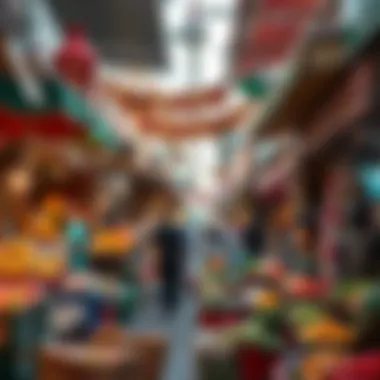

The diverse demographics and rich cultural landscape effectively create a unique setting that resonates with investors and homebuyers seeking not just property, but a vibrant lifestyle.
To summarize, the demographics and culture of the Dubai Metropolitan Area are significant factors that drive investment potential. Investors and real estate professionals need to consider the diverse population and the cultural institutions that foster community spirit when assessing opportunities in this thriving region. By understanding these dynamics, one can better navigate the market and cater to the needs of this eclectic community, ensuring both success and sustainability.
Economic Landscape
The economic landscape of the Dubai Metropolitan Area serves as a cornerstone for understanding its rapid evolution. The dynamics of commerce, finance, and innovation create a rich tapestry where opportunities are waiting to be tapped. This region is more than just a geographical entity; it is a thriving ecosystem fueling growth and attracting global talent and investment. Understanding this landscape is essential for anyone considering a stake in the burgeoning market of Dubai.
Business Environment
The business environment in Dubai is characterized by its openness and welcoming nature. Over the last few decades, it has transformed into a melting pot that nurtures various business types. The government has implemented policies aimed at streamlining processes, allowing entrepreneurs and well-established businesses alike to thrive.
- Free Zones: The Emirates boasts over 30 free zones where businesses can benefit from 100% foreign ownership, tax exemptions, and simplified regulations. This has made it easier for international companies to set roots in Dubai.
- Supportive Regulatory Framework: The legislation surrounding company formation and trade has evolved, keeping pace with global standards. Prospective investors appreciate ease of licensing, which significantly reduces bureaucratic red tape.
- Diverse Economic Sectors: Dubai's economy is not limited to oil; it encompasses various sectors including tourism, logistics, and technology. This diversification is pivotal in mitigating risks commonly associated with over-reliance on a single industry.
Given these facets, it's clear that the business environment of the Dubai Metropolitan Area provides a fertile ground for economic interaction and growth.
Key Economic Drivers
Understanding the drivers behind this thriving economy offers critical insights:
- Tourism and Hospitality: With attractions like the Burj Khalifa and numerous shopping festivals, tourism contributes significantly to the economy. The hospitality sector not only generates revenue but also creates employment opportunities across various skill levels.
- Trade and Logistics: Dubai's strategic location as a gateway between East and West makes it a global trading hub. The ports and airports operate at a scale that facilitates a high volume of trade movements. This has led to a robust logistics infrastructure built to accommodate the ever-growing demand.
- Technology and Innovation: The push towards becoming a smart city has ushered in an era where technology plays a vital role in daily operations. Investments in tech startups and advancement in IT infrastructure have placed Dubai on the map as a leader in innovation.
- Financial Services: The Dubai International Financial Centre (DIFC) stands as a prominent financial free zone providing a conducive environment for banking, asset management, and investment activities. This attracts multinational corporations as well as start-ups looking for financial backing.
In essence, the economic drivers are intertwined, creating a complex web that fuels Dubai's growth story.
When it comes to investors, understanding the economic landscape allows for better decision-making. It highlights the interplay between various sectors and pinpoints opportunities that can be leveraged now and into the future. For further details, insights can be drawn from resources like Encyclopedia Britannica or Dubai's official government portal.
Real Estate Overview
The real estate landscape in the Dubai Metropolitan Area plays a pivotal role in showcasing the region's growth potential. This sector not only serves as an index of economic health but also reflects the Dubai ethos of innovation and luxury. The rapid expansion of urban infrastructure and the increasing influx of diverse populations have created an enticing environment for real estate investment. Given this context, understanding the real estate market context becomes vital for anyone looking to buy, sell, or develop property.
Real estate represents one of the pillars of the economy in Dubai, supporting a spectrum of businesses and services. Moreover, the social life and lifestyle of residents are deeply intertwined with this sector. The trends within residential and commercial markets both cater to the evolving needs of residents and the demands of international investors, further positioning Dubai as a formidable player on the global real estate stage.
Investing in real estate here presents unique considerations:
- Growth Potential: The ongoing development projects continue to increase property values and rental yields over time.
- Diverse Offerings: From high-end luxury apartments to commercial spaces, the choice caters to different segments of buyers.
- Government Support: Policies aimed at attracting foreign investment contribute to a promising investment environment.
As we delve deeper, the next sections will provide specific insights into the current market trends and opportunities available for prospective investors.
Residential Market Trends
The residential market in the Dubai Metropolitan Area is a blended mix of luxury, modernity, and sustainability. Over the past few years, a notable trend has been the increasing popularity of community living, with developments like Arabian Ranches and Dubai Hills Estate garnering the attention of families seeking a more suburban lifestyle while retaining proximity to the city’s amenities.
Additionally, the ongoing emphasis on affordable housing has gained traction. Developers are starting to cater to a wider range of buyers. This move is part of a broader strategy to appeal to expatriates looking for long-term residency options. Trends show a marked increase in demand for smaller, but cleverly designed living spaces, reflecting a shift in lifestyle preferences.
Recent statistics highlight:
- Price Adjustments: Prices have stabilized after a period of fluctuations, offering clarity to buyers.
- Rental Insights: High demand in areas like Dubai Marina and Downtown is supporting consistent rental yields.
- Co-living Spaces: This emerging trend is particularly popular among young professionals, providing flexible living options with communal amenities.
In summary, the residential landscape is not just about numbers; it details a narrative of evolving preferences and economic responses.
Commercial Real Estate Landscape
Turning to commercial real estate, Dubai’s strategic positioning as a business hub is significantly influencing the market here. The demand for office space is on the rise, especially in technology-driven sectors as businesses expand and new players enter the market. Areas like Business Bay and Dubai Internet City show a healthy mix of established firms alongside startups looking to capitalize on the UAE's favorable business climate.
The surge in e-commerce is also propelling growth in logistics and warehousing facilities, providing abundant opportunities for investors in this niche. The delivery of services fueled by the internet underscores a trend toward innovation, making commercial real estate a pivotal area to watch.
Key insights about this segment include:
- Innovation Hubs: There’s a drive to create spaces that foster creativity and collaboration, leading to shared workspaces gaining prominence.
- Retail Dynamics: Retail spaces are also adapting to modern consumption patterns, with a notable emphasis on experiences over mere transactions. Malls are being designed as social spaces that host events and community activities.
- Sustainability Practices: As businesses become more environmentally conscious, eco-friendly buildings are emerging as a standard expectation rather than a luxury.
Architectural Innovation and Design
In the vibrant tapestry of the Dubai Metropolitan Area, architectural innovation and design play a pivotal role in shaping not only the skyline but also the very identity of this bustling hub. The interplay between functionality and artistic expression is crucial, as structures are not merely built for utility but are crafted to inspire. As Dubai continues to rise, both literally and figuratively, the emphasis on innovative architecture becomes key to attracting global investors and residents alike.
The significance of architectural innovation lies in its ability to transform spaces into functional works of art. Each building adds to the unique landscape, demonstrating how creativity meets practicality. Designers and architects are challenged to think beyond conventional styles, often merging various cultural influences to create spaces that are not just structures, but icons. This creates a narrative that reflects the region's dynamic spirit, which is essential for any investor or stakeholder eyeing the real estate market.
"In architecture, space is not merely a backdrop for our lives, but a catalyst for our experiences."
Iconic Structures
When one speaks of iconic structures in Dubai, several landmarks immediately come to mind, each serving as a testament to the city’s architectural prowess. Structures such as the Burj Khalifa—standing tall as the world's tallest building—captivate with their sheer scale and design ingenuity. It’s not just about height; it’s about innovative engineering and aesthetics combined.
Moreover, the Burj Al Arab, with its distinctive sail-shaped silhouette, is an emblem of luxury and design audacity. These buildings embody more than just functionality; they tell stories, represent cultures, and invite admiration from around the globe.
Here are a few notable aspects of these iconic structures:
- Cultural Symbolism: Many structures like the Dubai Frame reflect the city's past and future, bridging cultural heritage with modern aspirations.
- Architectural Techniques: Advanced building techniques and materials are employed in designs to ensure longevity and sustainability, vital for the region's climate.
- Tourism Attraction: Each iconic building draws millions of tourists annually, adding socio-economic value to the community.
Sustainable Development
Sustainable development in architectural practices is no longer a preference; it’s becoming a necessity, especially for investors eyeing Dubai. The city is proactive in embracing sustainable architecture, which aligns with global trends towards environmentally friendly construction. This consideration has significant implications not only for the environment but for property values and appeal.
A successful example can be seen in the Masdar City—an ambitious project that encapsulates the principles of eco-friendly design. The goal here is to create a zero-carbon city that serves as a model for future developments. Factors contributing to sustainable architecture include:
- Energy Efficiency: Use of renewable energy sources like solar panels to power buildings and reduce energy consumption.
- Water Conservation: Implementation of systems that minimize water use and promote recycling of resources.
- Innovative Materials: Incorporating materials that are either recycled or sustainably sourced, offering durability while reducing environmental impact.
Investing in properties designed with sustainability in mind not only meets the regulatory requirements but also aligns with the values of a growing segment of eco-conscious consumers and investors. This forward-thinking approach is essential as it significantly enhances the attractiveness of the real estate portfolio in Dubai, ensuring that it continues to be a land of opportunities.
Transport Infrastructure
An efficient transport infrastructure is the backbone of the Dubai Metropolitan Area. It facilitates economic growth, enhances connectivity, and improves the overall quality of life for residents and visitors alike. By examining the public transportation systems as well as road networks and connectivity, one can comprehend the pivotal role infrastructure plays in contributing to Dubai’s reputation as a flourishing metropolis.
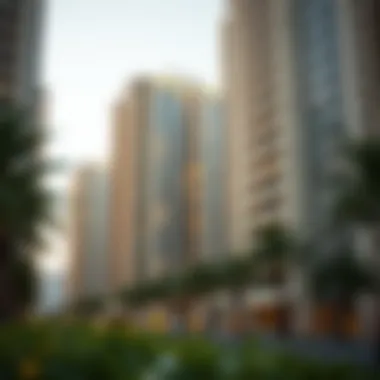

Public Transportation Systems
In a bustling urban environment like Dubai, a robust public transportation system is essential. The city has made strides in developing an extensive network that not only meets the needs of its population but also promotes sustainability. The Dubai Metro, for instance, is a shining example of modern transport innovation. It operates on a driverless system, providing high-frequency service that connects key areas of the city, thus reducing the dependence on private cars.
Other noteworthy public transport options include:
- Buses: With routes covering nearly every corner of the metropolitan area, buses are a convenient and cost-effective travel option. Their integration with the Metro offers seamless connections.
- Tram System: Specifically designed for the Dubai Marina and Al Sufouh areas, the tram provides an efficient means of navigating these densely populated zones.
- Water Taxis: Leveraging the city's breathtaking coastlines and waterways, these taxis offer a scenic alternative for locals and tourists, enhancing the overall public transportation experience.
The RTA (Roads and Transport Authority) continually aims to improve and expand transportation options, making it an important player in enhancing the infrastructure landscape.
Road Networks and Connectivity
Dubai’s road networks are meticulously planned, allowing for quick and easy access to all major districts. Major thoroughfares like Sheikh Zayed Road exemplify this connectivity, linking various neighborhoods and business hubs efficiently. Not only do these roads accommodate high volumes of traffic, but they are also designed with safety and convenience in mind.
Highlights of Dubai’s road connectivity include:
- Multi-lane highways: These routes ensure smooth traffic flow and significantly reduce travel times.
- Intelligent Traffic Systems: Advanced technology is utilized to monitor traffic density and adjust signal timings, minimizing congestion.
- Accessibility: Roads feature well-placed signage and pedestrian crossings, making it easier for all users to navigate the area safely.
Dubai’s commitment to enhancing its transport infrastructure cannot be overstated. It not only supports the daily lives of residents but also positions the city favorably for investors, further solidifying its reputation as a leading global investment hub.
"A well-connected city is not just about roads and rails; it’s about ensuring people can thrive in their everyday lives."
As such, transport infrastructure is an indispensable aspect of Dubai’s continuing evolution, influencing everything from real estate trends to quality of life.
For further information on transport policies, visit the RTA official site.
Additionally, you might find useful insights on the economic impact of transport in urban areas at Britannica.
This interconnected network supports Dubai’s ambitions and underscores its potential as a land full of possibilities.
Investment Opportunities
The Dubai Metropolitan Area offers a plethora of investment opportunities that stand out due to its dynamic economy and strategic location. This section sheds light on the key elements that make this region particularly appealing for investors.
Market Analysis for Investors
Investors looking at the Dubai market should be keenly aware of several trends that are shaping its landscape. Over recent years, Dubai has gained a reputation as a thriving hub for both residents and businesses, creating a robust environment for investments.
- High Demand for Properties: The continuous influx of expatriates and tourists contributes to a high demand for residential and commercial properties. A rising population coupled with an expanding economy means that these assets are more likely to appreciate in value.
- Regulatory Framework: Dubai’s government has implemented a conducive regulatory environment that encourages foreign investments. Recent updates regarding property ownership laws have allowed foreigners greater freedom to invest, which has bolstered market confidence.
- Variety of Investment Assets: Investors have the option to invest in various asset classes, including residential, commercial, retail, and hospitality. This diversity allows for better portfolio management and risk mitigation.
- Attractiveness of Rental Yields: The rental yields in Dubai consistently rank among the highest in the world, making it an attractive destination for investors seeking passive income. Areas like Dubai Marina and Downtown Dubai often yield upwards of 8-10%.
Emerging Neighborhoods
The landscape of Dubai is also shaped by emerging neighborhoods that promise a wealth of opportunity. These areas often combine affordability with potential for substantial growth.
- Dubai South: Envisioned to support the Expo 2020 legacy, this area has been earmarked for tremendous growth. With its proximity to the Dubai World Central Airport, it is transforming into a global logistics hub, thus attracting numerous businesses and investors.
- Meydan: This community is known for its luxurious developments and the iconic Meydan Racecourse. The growing demand for high-end residences and commercial spaces in this area presents a chance for early investors to capitalize on future growth.
- Jumeirah Village Circle (JVC): Offering a mixture of apartment living and villas at comparatively lower prices, JVC has been gaining traction among young professionals and families. This suburb’s strategic location and developing infrastructure make it increasingly appealing.
- Dubai Creek Harbour: This upcoming waterfront project is also making waves. With ambitions of offering a stunning skyline comparable to Downtown Dubai, this neighborhood is bound to attract investments in real estate, hospitality, and retail sectors.
"Investing in Dubai is not just a short-term play; it’s about capitalizing on long-term growth and innovation."
Epilogue
In summary, the Dubai Metropolitan Area is rich with avenues for investment, backed by strong demand, regulatory support, and emerging neighborhoods that promise growth. Investors who keep a finger on the pulse of these changes may find themselves reaping the rewards in the years to come.
Government Policies and Regulations
Understanding government policies and regulations is crucial when navigating the complexities of the Dubai metropolitan area, especially for investors and real estate professionals. These frameworks not only guide potential investments but also fortify the legal landscape in which they operate. The government provides a structured approach to how real estate transactions occur, which directly influences market stability and growth potential. The regulatory environment is established to foster a secure and attractive market for both local and foreign investors.
Key aspects of the regulatory framework include land ownership laws, zoning regulations, and property management guidelines. For example, the Dubai Land Department oversees various facets of property management and development, ensuring that all real estate activities comply with local laws. Understanding these regulations helps mitigate risks associated with investment, allowing stakeholders to plan effectively.
Factors to consider within the realm of government policies include:
- Transparency: Clear regulations enhance trust within the market, both for buyers and sellers alike.
- Legal Protection: Investors benefit from a well-defined system that protects their rights and investments through comprehensive property laws.
- Stability: A consistent regulatory framework contributes to market resilience, even in times of economic fluctuation.
In summary, grasping the nuances of government policies and regulations is essential for anyone looking to make informed decisions in the Dubai metropolitan area. As the landscape continues to evolve, staying abreast of changes in law and policy will enable investors to thrive in this dynamic environment.
Real Estate Laws
Real estate laws in Dubai serve to create a framework that not only protects the interests of property owners but also stimulates foreign investments. The laws governing real estate transactions are diverse, addressing varying elements from ownership rights to property registration. An essential component is the freehold property ownership law, which permits non-UAE citizens to own property in designated areas. This law has transformed the market, opening up opportunities for global investors eager to stake a claim in one of the fastest-growing cities in the world.
Moreover, the implementation of a comprehensive property registration system by the Dubai Land Department ensures accuracy and transparency in ownership records. Such measures significantly boost investor confidence, knowing that their assertions of ownership will be legally upheld. Additionally, laws regarding rental and leasing agreements ensure that both landlords and tenants have their rights observed and protected, fostering a harmonious living environment.
Incentives for Investors
Dubai's government recognizes the significance of foreign investment for economic growth. As such, it has rolled out several incentives that appeal to local and international investors alike. These incentives include:
- Zero Property Tax: Unlike many other global cities, Dubai does not impose property taxes on real estate owners, making it a lucrative destination for investors seeking better returns.
- Long-Term Visas: Under new regulations, investors committing substantial funds into real estate are eligible for long-term residency visas, providing them with added stability in their investments.
- Investment Funds: The government has initiated various investment funds aimed at boosting specific sectors, including real estate, further encouraging investors to participate actively in the market.
"Attracting global investment is part of Dubai's strategic vision, where incentives are thoughtfully designed to cultivate a flourishing economic landscape."
The combination of these benefits paints a picture of an attractive investment landscape, one that few other cities can rival. For real estate agents and developers, understanding these incentives is key to effectively guiding clients and maximizing investment potential. As policies continue to evolve, remaining informed about these elements will play a pivotal role in successfully navigating the Dubai market.
Challenges in the Market
Navigating the real estate landscape in Dubai can often feel like sailing through turbulent waters. The success of investments hinges not only on the appeal of the properties or the vibrant market but also on the challenges that arise. Investors and buyers need to grasp these hurdles to make informed decisions. Understanding these market challenges is paramount for anyone looking to plant their roots or expand their portfolio in this region.
Price Fluctuations
A defining characteristic of the Dubai real estate market is its propensity for price fluctuations. These ups and downs can be likened to a roller coaster, where markets swing dramatically due to a plethora of factors. Seasonal trends play a role; during peak tourist seasons, for example, demand spikes, which can drive prices up. However, during slower periods, prices may see a dip, sometimes sharply.
Additionally, the speculating behavior of investors often impacts price stability. With many buyers casting a wide net across the market, even minor news can lead to significant price shifts. For example, announcements regarding regulatory changes or new infrastructure projects can spark immediate interest or skepticism, resulting in rapid price shifts. This can make it difficult for a buyer to know when to buy or sell, and for investors to project long-term values.
"Understanding the volatility in pricing is crucial—it can make the difference between a good investment and a regrettable one."
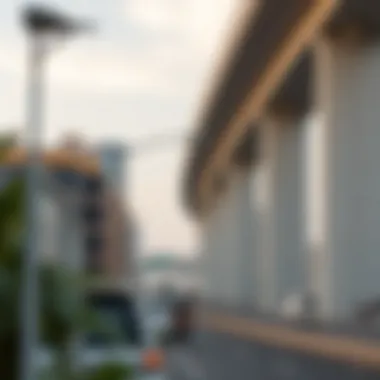

From the perspective of a buyer, recognizing these fluctuations is essential when deciding on the timing of purchases. Investors should conduct thorough research and potentially consult with local experts to gauge market sentiment and get insights on when to capitalize on these price movements.
Regulatory Hurdles
Another considerable challenge relates to the regulatory framework governing real estate transactions in Dubai. These laws can feel rather labyrinthine, often leaving newcomers feeling overwhelmed. For instance, foreign investors must navigate a complex set of regulations to own property in certain areas, and each development project may have its own rules affecting timelines and procedures.
Moreover, changes in government policies can compel buyers and investors to stay on their toes. The introduction of new taxes or revised ownership laws can alter the investment landscape dramatically. An example of this is the introduction of the property tax in certain Emirate regions, which has caused ripples in the market.
Potential buyers often find themselves entangled in bureaucratic red tape that can delay transactions and add unforeseen costs. Thus, understanding these regulatory hurdles is not just advisable; it’s an absolute necessity. Consulting with legal experts or seasoned real estate agents familiar with local laws can help mitigate these risks and steer investors away from pitfalls.
In summary, the challenges in the Dubai real estate market are not to be underestimated. Price fluctuations require vigilant observation, while regulatory hurdles necessitate thorough understanding. Navigating these complexities can lead to successful investments, making it crucial for investors, buyers, and real estate professionals to address these challenges head-on.
Future Prospects
The Future Prospects section sheds light on the evolving dynamics of the Dubai Metropolitan Area. With rapid development and a constant influx of innovations, comprehending where this region is headed is paramount for investors, real estate professionals, and potential buyers alike. Recognizing future growth patterns can mitigate risk and maximize returns, while being aware of innovative trends offers insights into what the market may demand in the years to come.
Projected Growth Patterns
Dubai's landscape is continuously transforming, characterized by ambitious projects and visionary policies. The government of Dubai has set forth several initiatives aiming to strengthen economic diversification and infrastructural expansion.
- Population Growth: Studies predict that Dubai's population will continue to escalate, with estimates suggesting it might swell to over 5 million by 2030. This demographic shift will pressurize the housing sector, increasing the demand for both residential and commercial real estate.
- Urban Expansion: Areas like Dubai South are indicative of how suburbs evolve. Plans for Dubai Creek Harbor highlight ambitions to integrate nature with urban living, creating appealing communities that draw buyers.
- Sustainability Initiatives: Under Vision 2040, the city aims to foster sustainable living environments. Increased interest in eco-friendly projects will attract a new wave of investors.
The Impact of Infrastructure
Infrastructure development is intricately tied to economic growth. For example, the expansion of the Dubai Metro and new road projects such as the Dubai Ring Road enhancement prepares the city for a surge in inhabitants and visitors. This kind of investment enhances property values and attracts businesses eager to capitalize on improved access.
"The 2040 Urban Master Plan emphasizes not only growth but balancing population density with quality of life."
In essence, the growth of this metropolitan area is underpinned by a healthy interplay of governmental policy, infrastructural commitment, and changing demographics. Investors must carefully consider these factors when looking to partake in this fast-moving market.
Innovative Trends on the Horizon
As technology continues to intersect with daily life, the Dubai Metropolitan Area is swiftly adapting to embrace this evolution. Here are some innovative trends worth noting:
- Smart City Developments: Initiatives promoting smart cities aim to leverage technology for urban living. Projects like the Dubai Smart City initiative are set to make resources like energy more efficient, thereby enhancing property appeal. This blend of tech and real estate can result in higher ROI for investors.
- Blockchain in Real Estate: Pioneering the implementation of blockchain technology, Dubai is leading the way in transparent and efficient property transactions. The Digital Real Estate initiative streamlines processes, cutting down time and costs significantly, which can further benefit investors and sellers.
- Sustainable Building Practices: There is an accelerated shift towards sustainable methodologies, driven by both regulatory standards and consumer preference. Properties that focus on energy efficiency can command premium prices, making this a crucial consideration for developers.
Investors should remain alert to these trends as they represent not just opportunities for profit but also avenues for contributing positively to the community and environment.
For further insights:
Impact of Technology
In today's fast-paced world, technology plays a critical role across various sectors, and the Dubai Metropolitan Area is no exception. The integration of technology into daily life enhances both the efficiency and the quality of living in this urban landscape. For investors, buyers, and real estate professionals, understanding the ramifications of technological advancements is pivotal. Here are a few facets to consider:
- Enhanced Infrastructure: Smart technologies streamline urban planning and allow for efficient resource management, paving the way for more sustainable growth.
- Data-Driven Insights: The increasing reliance on data analytics in real estate can uncover trends and opportunities that may not be immediately obvious, giving stakeholders a competitive edge.
- Improved Connectivity: Technology has revolutionized communication and accessibility, especially in a city known for its rapid expansion. Investors can effortlessly assess properties and trends, thus making more informed decisions.
The implications of technology stretch far and wide in the Dubai Metropolitan Area, transforming it into a hub where innovation meets opportunity.
Smart City Initiatives
Dubai is not just a city but a blueprint for smart urban living. Its Smart City initiatives aim to elevate the urban experience, merging cutting-edge technology with daily life. Here are a few highlights:
- Smart Traffic Management: Advanced systems monitor traffic flows, reducing congestion and improving road safety. Real-time data lets commuters adapt their routes dynamically.
- Energy Efficiency: Buildings equipped with smart technology aim for sustainability without sacrificing elegance. Design elements that capture sunlight, paired with innovative energy management systems, create environmentally friendly spaces.
- Public Facilities: Wi-Fi hotspots and sensor-based waste management in parks and streets showcase the commitment to seamless public services. These amenities not only improve life but also raise property values in surrounding areas.
“With forward-thinking policies and initiatives, Dubai is not only embracing technology but is redefining the experience of urban living.”
Real Estate Tech Advancements
The real estate sector in the Dubai Metropolitan Area is on the brink of a technological revolution, transforming how properties are bought, sold, and managed. Some notable advancements include:
- Virtual Tours and Augmented Reality: Prospective buyers can now explore listings from the comfort of their homes, providing a more comprehensive viewing experience without the hassle of physical visits.
- Blockchain in Transactions: This innovation promises enhanced transparency and security in property transactions. By cutting out the middleman, buyers and sellers stand to save time and reduce costs.
- AI in Property Valuation: Artificial intelligence tools analyze vast datasets to provide accurate property valuations, helping buyers and sellers achieve fair prices.
These advancements make the Dubai Metropolitan Area an attractive landscape for discerning investors and buyers looking to capitalize on emerging technologies.
Local Amenities and Lifestyle
When diving into the intricacies of the Dubai Metropolitan Area, the discussion on local amenities and lifestyle represents a cornerstone of attractiveness for potential residents and investors alike. This vibrant urban hub is not merely a place where people live; it's a thriving ecosystem that nurtures both wellbeing and growth. Access to a diverse range of amenities can significantly influence a person's decision to relocate or invest, making this exploration paramount.
Education and Healthcare
Education and healthcare are foundational elements in any community, and the Dubai Metropolitan Area excels in both fields. The region offers a plethora of international schools, catering to various curricula including British, American, and Indian systems. Notably, institutions like Dubai International Academy and GEMS Education have made a name for themselves, providing high-quality education that meets global standards.
On the healthcare front, the Dubai Metropolitan Area boasts some of the finest medical facilities in the world. Hospitals such as Cleveland Clinic Abu Dhabi and Dubai Healthcare City are well-equipped with state-of-the-art technology and staffed by highly skilled professionals. The easy access to quality healthcare services enhances the living experience, providing peace of mind for families and individuals alike.
"The presence of reputable educational and healthcare institutions signals a thriving community, ideal for those seeking a balanced lifestyle."
Leisure and Recreation Spaces
Leisure and recreation are equally critical when discussing the quality of life in Dubai. The metropolitan area is renowned for its stunning parks, leisure facilities, and cultural hubs. Jumeirah Beach is a prime example, where both locals and tourists come to enjoy the sun and sea, accompanied by an array of cafes and restaurants lining the waterfront.
Moreover, the city is home to expansive parks like Zabeel Park and Al Barsha Park, where residents can engage in recreational activities or simply unwind surrounded by lush greenery. The Dubai Marina walk, with its stunning views, provides a perfect setting for evening strolls, drawing people out to socialize.
For those who enjoy a more active lifestyle, facilities like The Track, Meydan Golf, and IMG Worlds of Adventure offer a mix of leisure and excitement that caters to different preferences.
In summary, local amenities and lifestyle in the Dubai Metropolitan Area play a pivotal role in its appeal. With an emphasis on excellent education, outstanding healthcare services, and a variety of leisure activities, this area is not just a place to live — it's a vibrant, dynamic community geared towards enhancing the quality of life for its residents.
Epilogue
The journey through the Dubai Metropolitan Area's multifaceted landscape paints a vivid picture of a region ripe with potential. The conclusion draws together the threads of various discussions, showcasing how the blend of historic transformation and modern innovation shapes Dubai into a genuine hub for opportunity.
Investors and homeowners alike benefit from the unique offerings this metropolitan area provides. As we have explored, factors such as a diverse cultural environment, strategic location, and robust economic landscape serve as powerful incentives for those considering entering the market. Here are some key takeaways on the importance of the conclusion:
- Cohesion of Insights: The importance of having a coherent understanding of Dubai’s residential and commercial realms can’t be overstated. Each sector of the market connects to create a whole, enhancing the appeal for both buyers and investors.
- Evaluating Growth Potential: The anticipated growth patterns discussed earlier establish a solid foundation for evaluating investment returns. Investors can approach the Dubai market with a clearer perspective, identifying areas with promising potential and reducing risk.
- Recognizing Challenges: Addressing market challenges shows that understanding the landscape is crucial for success. Sound knowledge of price fluctuations and regulatory hurdles allows stakeholders to make informed decisions, safeguarding their interests.
- Leveraging Local Amenities: Highlighting the lifestyle benefits, such as education, healthcare, and recreational spaces, illustrates that Dubai isn’t just about business opportunities. It's also about living a fulfilling life, which is increasingly paramount for modern investors and residents.
In essence, the insights gained from this narrative serve as a guiding compass for navigating the dynamic waters of the Dubai Metropolitan Area. As the region continues to evolve, staying informed and adaptable will empower investors, developers, and residents alike to make the most of the abundant opportunities that lie ahead. This isn't just a place to live—it's an investment in the future.
